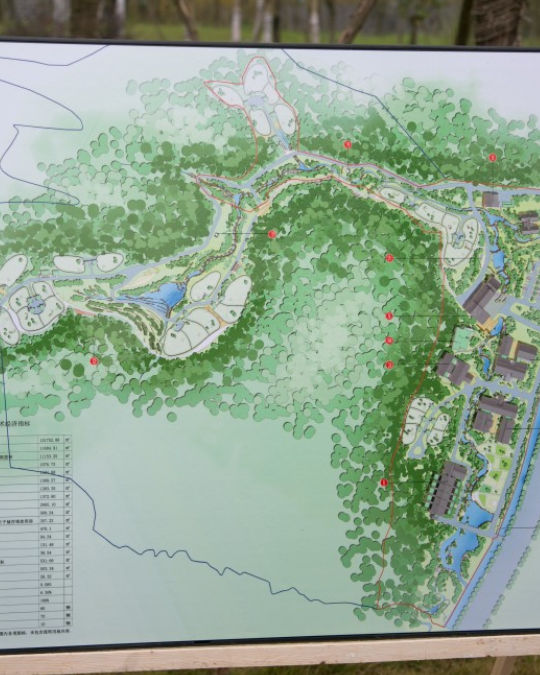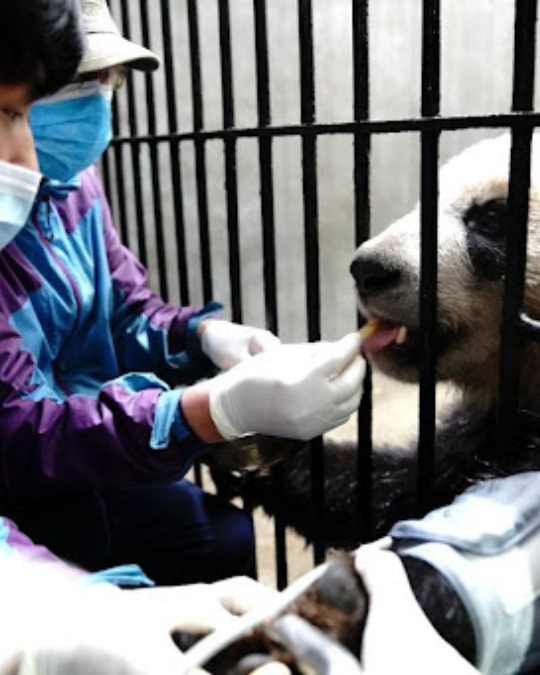Set in Dujiangyan’s scenic mountains, the Dujiangyan Panda Base Pandemic Center serves as a sanctuary for the world’s beloved giant pandas. In this particular blog post, I will focus on the Center’s conservation efforts, the Center’s unique visitor experiences, and the stunning natural beauty around it. I will share with you insightful information on the base’s role in the giant panda research as well as the volunteer programs that offer an immersive learning experience to ensure that your trip is indeed unforgettable. Be it a wildlife lover, a nature lover, or someone just curious about the gentle giants, this blog combines all the information that would help make the trip to the Dujiangyan Panda Base.
What Makes the Dujiangyan Panda Base Unique?

What Makes the Dujiangyan Panda Base Unique
The base is renowned for combining panda conservation efforts with public education. Unlike other centers, this one specializes in the healing and rehabilitation of sick and injured panda bears by providing them with professional medical care and recovery in a natural environment. In addition, the base introduces programs where visitors can see and learn panda behavior, their ecological importance and the work done for their conservation. Its combination of some of the most modern and effective research, education activities, and peaceful surroundings make this base a premier destination not only in China but in the world for panda lovers.
Overview of the Dujiangyan Panda Conservation Efforts
The Dujiangyan Panda Base operates as a critical hub for panda conservation, emphasizing medical rehabilitation, rescue operations, and species reintroduction. Key conservation efforts include:
- Medical Care and Rehabilitation
- The base is equipped with advanced veterinary facilities tailored for panda-specific care, ensuring effective treatment for injuries and illnesses.
- Parameters include a controlled habitat with a temperature range of 15-24°C, mimicking pandas’ natural mountain environment.
- Breeding and Reintroduction Programs
- Special breeding areas provide pandas with a natural and stress-free environment conducive to reproduction.
- Cubs bred in captivity undergo progressive training to adapt to wild conditions before reintroduction.
- Habitat Restoration and Research
- Active efforts are made to restore bamboo forests, ensuring a sustainable food supply essential for wild pandas.
- Data from behavioral studies, habitat use, and dietary needs inform rewilding strategies.
- Community Engagement and Education
- Through workshops, interactive experiences, and volunteer programs, the base raises public awareness about pandas’ ecological importance.
- Visitors can engage directly by planting bamboo or observing panda behaviors under guided supervision.
By combining these efforts with international collaborations and integrating research into practice, Dujiangyan plays a pivotal role in the global mission to ensure the survival of giant pandas.
Exploring the Panda Valley and Its Natural Habitat
Panda Valley, located in Dujiangyan, Sichuan, is a sanctuary aimed at creating a semi-wild environment for giant pandas. Its area covers about 133 hectares, serving as a perfect habitat for pandas to transition from captivity to their natural self. The valley has an incredibly diverse ecology, containing bamboo forests, streams, and a variety of wildlife and flora that resembles the panda’s native home. This environment makes it possible for pandas to hone basic survival skills such as foraging for bamboo, climbing, and evading a predators.
The facility does not only foster panda’s passive natural behaviors but also features modern remote-control monitoring equipment. A collar with a fastened GPS unit and surveillance cameras on area fences provide information about the panda’s behavior and health. The bamboo grown in the valley is so deliberately crafted that they are hypothetically bountiful. People coming to Panda Valley have a once-in-a-lifetime chance to witness pandas engaging in behavioral and enclosure enrichment activities while enjoying the wonders of nature.
Because of Panda Valley’s all-encompassing conservation and educational tactics, it is a worldwide benchmark for the preservation and reintroduction of wildlife. With the help of Panda Valley, both tourists and scientists can see marvelous conservation work in progress so that they can help this highly regarded species and its future.
Understanding the Dujiangyan Irrigation System and Its Impact on Panda Habitats
By maintaining the ecological balance of the region, the Dujiangyan Irrigation System stabilizes water supply to panda habitats. It provides sustainable irrigation while nurturing the lush forests necessary for agriculture within the region. Flooding is ingeniously controlled through this system which prevents the need for environmentally damaging dam construction. As a result, the forest ecosystem housing the Giant Panda is preserved. The enduring combination of human measures taken alongside environmental protection constructs a habitat for Pandas, furthering conservation efforts for biodiversity as well.
How to Volunteer at the Dujiangyan Panda Base

How to Volunteer at the Dujiangyan Panda Base
It is also possible to participate in volunteering opportunities, which serve as great ways to learn about pandas and assist in conserving them. A booking through their official website or a travel agency activates participation in a volunteer program. Most programs involve cleaning enclosures, preparing food, feeding, and educating the pandas. Some physical ability is necessitated for participants, as well as following instructions given by staff for the safety of both the volunteers and the pandas. As with many volunteer programs, it is best to reserve early as demand oftentimes makes spots limited.
Steps to Join the Panda Volunteer Program
- Research and Choose a Program
Go to the Panda Reserves’ official website or authorized travel agencies to see which volunteer programs most interest you and fit into your schedule.
- Check Eligibility Requirements
Be sure you cover the minimum requirements, such as being reasonably healthy, being able to do some physical exercise, and following any age limitations (normatively eighteen years old and over and above that unless the program says otherwise).
- Submit an Application
Complete an application form in which you will give out personal information like health data and the required program dates. You will send the form through the prescribed platform or travel agencies.
- Wait for Confirmation
Await until you are informed of your confirmation. This process could span days to weeks based on how many spots are available for the program.
- Prepare Travel Documents
Prepare all important documents for travel like a passport valid for at least six months from the date you intend to enter the country, and a visa if one is required. Check if vaccinations or any health issues need to be checked before going as instructed by the program.
- Pay Registration Fees
Validate and pay any registration or participation fees that may be necessary. The fees that will be charged usually include expenses for the program and may change depending on its length and the different services provided.
- Follow Pre-Departure Instructions
Check pre-departure instructions provided with the Program as it may detail arrival times, things to carry, and how to reach the point of interest.
- Join and Participate
Be punctual, take up your assigned duties, and follow the directions given by staff to guarantee a productive and secured volunteer experience.
Experiences as a Panda Keeper at the Base
Becoming a panda keeper volunteer allows individuals to enjoy the company of one of the most adored creatures on earth. Volunteers are usually involved in several activities like pandas’ feeding, cage cleaning, and behavior watching. Such activities make learners acquainted with the conservation efforts and daily care services for endangered species.
The learners are also educated on the existence biology of the panda, their habitat, and the problems associated with captivity breeding. Most programs blend education with practical conservation sessions to make the learners comprehend wildlife issues deeply. Direct contact with the professional staff and other volunteers enhances partnership and cooperation which is unforgettable for all the animal and environmental caretakers at heart.
Responsibilities and Activities in the Care Program
My obligations as a caregiver involve preparing bamboo and specialized biscuits for the pandas, as well as cleaning and tidying up their habitats. I also help with simple observation exercises to keep track of their health and behavior, facilitating the staff’s data collection. I further participate in lectures related to panda behavior, conservation, and the intricacies involved in breeding them. I work directly with a team of professionals and other volunteers to help care for the pandas and promote their welfare. With this experience, I can participate in the efforts to conserve wildlife helpfully.
How to Get to Dujiangyan Panda Base from Chengdu?

How to Get to Dujiangyan Panda Base from Chengdu
Traveling from Chengdu to the Dujiangyan Panda Base? You can hop on a direct bus from Chadianzi Bus Station which will take you to Dujiangyan City in an hour and a half. Afterward, a local taxi or bus will take you within minutes of your destination. If you prefer more comfort, you can rent a private car, join a guided tour, or hire a private driver. The travel time from Chengdu to the base is a comfy 2 hours.
Traveling Tips from Chengdu to Dujiangyan
Most Efficient Ways To Travel
High-speed Train: Get a high-speed train from Chengdu’s Xipu Station to Dujiangyan Train Station. The journey lasts approximately 30-40 minutes and train tickets usually cover a range of ¥15 to ¥30 based on the class with you traveling in. Taxis and local buses await, which will take you to the Dujiangyan panda base.
Bus: Buses from Chadianzi Bus Station in Chengdu take around 1.5 hours while costing something like ¥20-¥25. After arriving, you can then take a taxi or local transportation to the panda base.
Private Car or Taxi: You can hire a private vehicle and why not use taxi services that will take you anywhere in Chengdu or Dujiangyan? The trip from Dujiangyan to Chengdu will take roughly 1.5 to 2 hours depending on how traffic is as well and cost anywhere from ¥300-¥400.
Ideal Travel Times
Visiting the base and departing during the morning is suggested as the temperature is nice and cool and pandas tend to be more active.
Packing and Preparation
Clothes: Dujiangyan has a variety of weather conditions, therefore wearing appropriate and comfortable clothing is crucial. Be prepared to pack your rain gear if you visit between May to September.
Snacks and Water: It is best to carry a personal bottle of water and some light snacks as a courtesy to the travel services that provide them, as they plan to provide these services during the trip.
Buying Tickets Ahead of Time:
Make sure to set aside some time on the weekends or public holidays to purchase your train tickets and entrance passes to the panda base. This will save you from dealing with pangs of stress later on.
You can make your trip from Chengdu to the Dujiangyan Panda Basis smoother and more enjoyable by following these tips.
Exploring Dujiangyan City and Its Attractions
As much as Dujiangyan City is popular for its panda base, it is equally famous for its rich history and cultural sites. In the middle of the city is the ancient Dujiangyan Irrigation System which has been an engineering wonder for more than two thousand years, making it a UNESCO World Heritage Site. Founded during the Qin Dynasty, this system still serves its purpose of flood control and irrigation. It is a must-visit if you love history or engineering.
Another iconic site is Qingcheng Mountain, which is recognized as the “origin of Taoism.” This beautiful mountain not only has hiking trails but also ancient mountain-view Taoist temples which offer breathtaking views as one hikes up. Spiritual people and nature fans can be at peace and admire the tranquil Taoist temples. Don’t forget about the landmarks like Jianfu Palace and Shangqing Palace as all these places serve as a sanctuary from the hustling and bustling sound of the city.
Also worth experiencing is the city’s Anlan Suspension Bridge. This landmark offers amazing views of the Min River and the surrounding nature, making it one of the favorite spots for tourists. The bridge is affectionately called the “couple’s bridge” and provides light adventure combined with stunning visuals.
While visiting Dujiangyan, take some time to enjoy the local Sichuan cuisine, especially the mouthwatering map tofu, Sichuan hotpot, and kung pao chicken. The region’s rich culture is astonishingly showcased in its food.
If you are a lover of ancient history, natural beauty, or appetizing food, Dujiangyan City has everything you need for an unforgettable trip.
Visiting the Dujiangyan Irrigation Project as a Cultural Stop
Going to the Dujiangyan Irrigation Project as a cultural stop was surprising. It reflects the advanced technology of ancient Chinese hydrology and the balance achieved between man and nature. Observing the lavishly designed system of weirs and canals from the pathways, I was amazed at how the irrigation system helped sustain agriculture and flood prevention for over 2,000 years. Temples in the area and the surrounding beauty gave a taste of culture and history that blended so beautifully.
What is the Giant Panda Disease Prevention Program?

What is the Giant Panda Disease Prevention Program
The Giant Panda Disease Prevention Program seeks to protect giant pandas from any illnesses that could threaten their health and survival. This program aims to monitor the health of individual pandas, organize regular examinations, and study preventative measures for various diseases. They include: controlling the environments to minimize exposure to disease with proper nutrition, hygiene, and quarantine procedures for sick or newly arrived pandas, ensuring the transmission of diseases does not occur. Collectively, these efforts will help in better conserving the already fragile pandas.
The Role of the Center for Disease Control in Panda Health
The CDC takes the lead role in conserving wildlife health through its disease prevention, surveillance, and research programs. This includes watching over infectious diseases which can pose a danger to the panda population like CANINE DISTEMPER VIRUS (CDV) or parasitic infestation. The CDC works together with zoological institutions and conservation centers in developing immunization strategies and microbial testing to ensure that biosecurity systems are working as planned. Relevant technical specifications are both general and specific including regular health examinations every six to twelve months, a controlled environment for housing at a temperature range of 59 to 77 degrees Fahrenheit (15 to 25 degrees centigrade), structured feeding programs that provide 20 to 40 pounds (9 to 18 kilograms) of bamboo a day, etc. In combination, these efforts increase the understanding of disease outbreaks for the captive and wild panda populations enabling better genomic pathogen analysis and epidemiological studies. These combined efforts bolster the resiliency and sustainability of panda programs around the world.
Research and Treatments at the Panda Hospital
Here at the Panda Hospital, we dedicate our research and treatment programs to innovative interactions with the health issues faced by the giant pandas. We partner with leading institutions so that we can make advancements even in veterinary medicine, like taking proactive measures and rehabilitative therapies to help with injuries or illnesses. Our primary vision includes stress management like specialized vaccine development for the most prevailing problems such as canine distemper and parasite infestation. Work is also focused on nutrition for optimizing bamboo-based diets as the pandas have a unique digestive system. These efforts will provide exceptional care toward giant Pandas and help build a better global understanding regarding the health and conservation of Pandas.
Efforts in Panda Disease Prevention and Management
Having advanced diagnostic parameters facilities with high levels of vaccination and health monitoring aids in the effective management and prevention of diseases. During routine medical checkups, we try to screen patients for early signs of illnesses such as respiratory infections and gastrointestinal disorders. Also, medical techniques to control diseases such as canine distemper are provided, with dosage and schedules set according to the panda’s physiologic requirements. For example, the typical vaccine dosage given to an adult panda is 1mL which is given once a year.
Health conditions internally is monitored using imaging tools like ultrasounds or blood tests. Also, nutritional changes remain a vital aspect where diets of bamboo have to be checked if its fiber content is ideal which is 30-35% of bamboo per day. Such measures enable us to greatly reduce health risks whilst providing the animals and the world with valuable information for conservation efforts needed on a global scale.
Why is the Dujiangyan Panda Center Important for Panda Rescue?

Why is the Dujiangyan Panda Center Important for Panda Rescue
The rescue effort of The Dujiangyan Panda Center is distinguishable in its own right since it extends medical and healing services to injured and ill giant pandas. It offers sanctuary spaces in its facility considering the specialized medical treatment that has to be given to pandas. The center further participates in active panda conservation through the development of public education and research programs as well as panda reintroduction programs which aid in ensuring the wellbeing of the species. Given the extent of its functionality, it helps ensure that rescued pandas are in captivity for a minimum period enabling them to fully recover and reintegrate into protected habitats.
Understanding the Panda Rescue Operations
Dujiangyan Panda Center’s approach to caring for giant pandas and taking charge of rescue operations ensures that there is a balance between giving immediate care and long-term recovery. Once a panda is found to be in distress, our experts promptly administer rehabilitative medical attention based on their condition. To the extent possible, a reduction in stressful factors is vital in the environment provided to the panda. In addition to the immediate intervention, the center is also involved in research aimed at improving the treatment methods used and integrating strategic collaborations globally to achieve conservation goals. Compassionate innovative strategies are combined to ensure that irrefutable opportunity to thrive is afforded.
Contributions of the Dujiangyan Giant Panda Base to Global Conservation
Delving into advanced research education and international collaboration, we, as a global conservation partner, work with the Dujiangyan Giant Panda Base. Supported by top-notch genetic studies and reproductive health facilities, our state-of-the-art breeding programs have significantly increased the population of these endangered species. In addition, comprehensive support for both wild and captive pandas allows us to share global best practices such as habitat restoration and veterinary care advancements. Engaging global audiences, our education programs aim to create awareness of biodiversity and environmental sustainability. Along with other global conservation bodies, we strengthen the international network focussing on the conservation of giant pandas along with their ecosystems. During breeding programs, genetic analysis and monitoring techniques, for example, GPS collars, provide accuracy and functionality to our efforts. Collectively, these strategies empower us to contribute towards ensuring a future for giant pandas.
The Role of the Research Center for Giant Panda Conservation
The Research Center for Giant Panda Conservation provides facilities for scientific research, habitat protection, and breeding of giant pandas. It is a key center for current research on panda genetics, behavior, and health. It works with other countries to develop sustainable population growth plans which include artificial insemination and genetic diversity issues.
Panda habitat preservation is a further main focus which includes the regeneration of bamboo forests. Powerful tools like GPS collars and remote cameras permit the monitoring of the health and movement of pandas in nature. From an educational standpoint, the general public is made aware, trained, and motivated toward biological diversity and its conservation with particular attention to endangered species. The center is active in the management and conservation of giant pandas, which ensures they survive in the wild and in captivity for years to come.
References
Frequently Asked Questions (FAQ)
Q: What is the Dujiangyan Panda Base?
A: The Dujiangyan Panda Base is a sanctuary dedicated to the conservation and research of giant pandas. It is part of the China Conservation and Research Center for the Giant Panda and focuses on giant panda breeding, rescue, and rehabilitation. The base is located in Qingchengshan, just outside the city center of Dujiangyan.
Q: How can I experience the Dujiangyan Panda Base in the best way?
A: To fully experience the Dujiangyan Panda Base, consider joining the volunteer program or taking a guided tour. This will allow you to learn more about the conservation efforts, get close to the pandas, and understand the intricacies of the base’s operations.
Q: What is the Dujiangyan Panda Base Volunteer Program?
A: The Dujiangyan Panda Base Volunteer Program offers visitors the opportunity to work alongside staff in caring for the pandas. Volunteers participate in activities such as preparing food, cleaning panda enclosures, and learning about panda conservation efforts. It is a rewarding experience for panda lovers.
Q: How does the Dujiangyan Panda Valley differ from other panda parks?
A: The Dujiangyan Panda Valley is unique due to its focus on rehabilitating and releasing pandas back into the wild. It provides a more natural habitat for the pandas compared to other parks, and it is closely connected to the research center for the giant panda, enhancing the educational experience for visitors.
Q: Can I take photos with the pandas at the Dujiangyan Panda Base?
A: Visitors can take photos in designated areas and during specific programs. However, interacting directly with the pandas for photo opportunities is restricted to ensure the safety and well-being of the animals.
Q: What facilities are available at the Dujiangyan Panda Base?
A: The Dujiangyan Panda Base includes a research base of giant panda breeding, an educational center, and visitor facilities. There is also a panda movie theater where guests can learn more about panda conservation efforts.
Q: Is there a connection between the Dujiangyan Panda Base and the Chengdu Research Base of Giant Panda Breeding?
A: Yes, the Dujiangyan Panda Base is part of the China Conservation and Research Center for the Giant Panda, which includes the Chengdu Research Base of Giant Panda Breeding. Both centers collaborate on panda conservation, research, and breeding programs.
Q: How can I get to the Dujiangyan Panda Base from the city center?
A: The Dujiangyan Panda Base is located in Qingchengshan, which is accessible by public transportation from the city center of Dujiangyan. Visitors can take a train or bus, or opt for a guided tour that provides transportation.
Q: Are there other attractions near the Dujiangyan Panda Base?
A: Yes, visitors can also explore the Dujiangyan Irrigation System, a UNESCO World Heritage Site, located nearby. It offers a fascinating look into ancient Chinese engineering and complements the visit to the panda base.
Q: What is the best time of year to visit the Dujiangyan Panda Base?
A: The Dujiangyan Panda Base can be visited year-round, but the best time is during the spring and autumn when the weather is mild. This allows for a comfortable experience while exploring the base and observing the pandas.